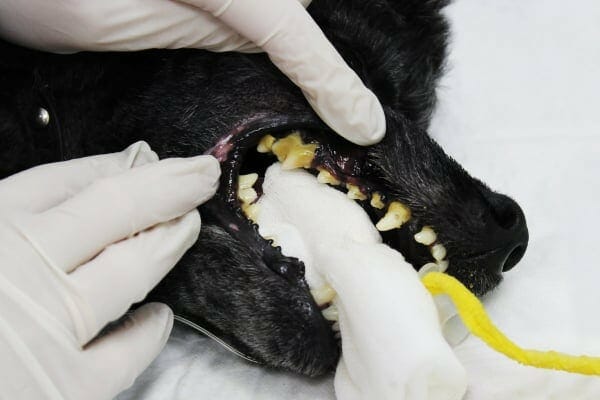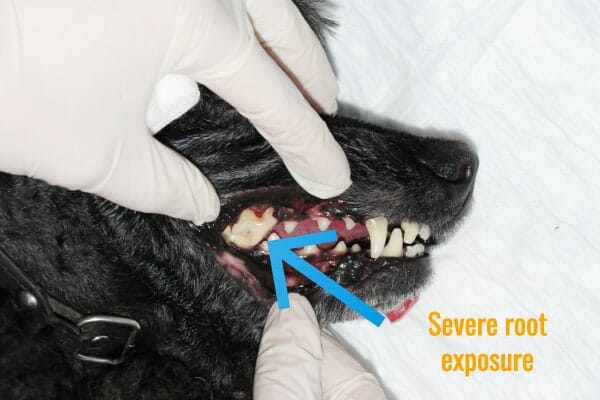Adult dog teeth – cleaning, hygiene and tooth loss.
But if your dog is older and has all their permanent teeth, it’s not normal if they fall out randomly.
If you’re practising good dog mouth hygiene and you’re regularly cleaning their teeth, this is a cause for concern and you should get your dog seen by your vet to rule out any potential underlying problems.
How can I help my older dog who is losing teeth?
First, let me be abundantly clear that if you’re wondering: “At what age do older dogs start losing teeth?” The answer is NEVER, at least not in an ideal world. Do older dogs lose their teeth? Yes, they do. I see it all the time in my practice. But, it’s not something we expect to happen as a part of the aging process. It’s not normal at any adult age. Take, for example, older people. Do you have an older parent or grandparent who is losing teeth? Maybe, but I’m guessing they are under the care of a dentist, endodontist, periodontist, oral surgeon, or some combination of these specialized doctors. We do not treat tooth loss as a “routine” part of aging for senior citizens. It happens, but it indicates something is wrong. The same holds true for old dogs. Do old dogs lose their teeth? Yes Should they? Hopefully not What do you do if your older dog is losing teeth? Read on…
If your older dog is losing any of their 42 teeth, a trip to the veterinarian is in order. By simply examining your dog’s mouth while she is awake, your vet can make some recommendations about how how to proceed. He or she might suggest putting your dog under general anesthesia so dental X-rays can be taken to determine the periodontal disease stage and formulate a treatment plan.
The most common treatment is a full dental cleaning while your dog is under general anesthesia. Your vet uses a dental prophylaxis machine to clean the teeth. An ultrasonic scaler breaks up and removes plaque and tartar. After that, a polisher smooths the surface of the tooth making it harder for bacteria to adhere and form plaque in the future. Sometimes a special gel is inserted below the gum line to help prevent future plaque and tartar from accumulating. These gels often contain an antibiotic to treat minor infections.


For the safety and comfort of your dog, X-rays and dental prophylaxis should always be performed under general anesthesia. It’s extremely difficult, even in the best behaved canine patients, to get dental X-rays without sedation. Also, cleanings won’t be as effective on an alert patient since the teeth can’t be cleaned or scaled below the gum line.
The “root” of the problem in periodontal disease lies with the 60% of the tooth below the gum line. Thus, a dental procedure must be able to assess and treat the whole tooth, not just make the visible portion of the tooth look pearly white again.
Make an appointment with the vet to prevent dog tooth loss
Whether you suspect injury or disease, your first stop should be the veterinarian’s office. If your pup recently had an accident that caused tooth loss, your vet can check their mouth to ensure no underlying issues may have contributed to it. They will also confirm that the entire tooth fell out. If part of it is still in the gums, it can lead to pain and infection down the line.
As for periodontal disease, the condition is unfortunately widespread in adult dogs. It is irreversible, and additional issues will arise the longer you wait to treat it. Schedule an appointment with the vet as soon as you notice any one of these periodontal disease symptoms:
If your dog has already been diagnosed with periodontal disease, your veterinarian can perform a professional dental scale and polish every few years. This can help protect the gums and teeth from further damage and prevent tooth loss.
It’s never too early to start thinking about your dog’s oral health. With these tips, you can protect your dog’s teeth and prevent periodontal disease. If your dog has already been diagnosed, these measures won’t reverse the disease, but they can help to prevent further degeneration.
Brush your pup’s teeth with a toothbrush and toothpaste made for pets. You don’t need to brush twice a day as you do for yourself; two to three times per week should suffice. Brushes are available with long handles (like regular, human toothbrushes) or in the form of rubber tips that fit on your fingers. There are also sprays, gels, and powders that can help remove plaque if your dog will not sit still for brushing.
Dog Loose Tooth! What to do and what to expect.
I’ve been this lucky as my little dog Rascal, a Pomeranian/Yorkie mix has celebrated his 18th birthday. This means in human years this good old boy is 126 yrs old!
As dogs age, a variety of health issues may come up. The most prevalent issue is the condition of their teeth.
Of course your best bet is to start a preventative maintenance program early, in order to help your dog keep his teeth as long as possible.
For my dog Rascal, once he passed middle age (about 8 or 9 years old) his teeth started going downhill.